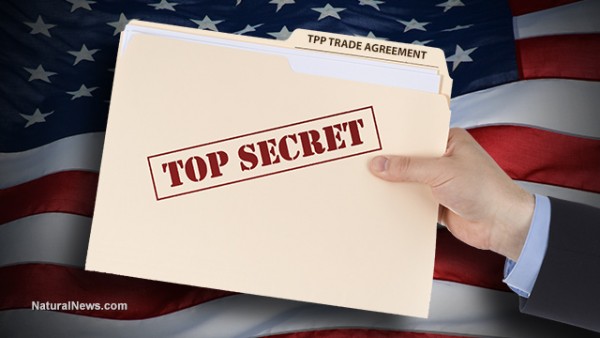There are several reasons to be opposed to the Trans-Pacific Partnership that many in Congress wanted to give President Obama fast-track authority to pursue and sign off on, before anyone in the Senate provided constitutional “advice and consent” and the American people got a chance to first see what was in it.
On that latter note, the Obama administration – using the absurd claim that transparency would kill the deal – went out of its way to keep details of what CNN called the “biggest free trade deal in history” a secret.
“Two copies of the biggest free trade deal in history are sitting in reading rooms – one at each end of the Capitol,” the network reported on its Web site.
“The document is classified. Only members of Congress and staffers with security clearance can access it. And they can’t make copies or even carry their own handwritten notes out the door,” it continued.
The network went on to say that’s how these deals are done: They are purposefully negotiated in secret so that governments don’t “undercut their own negotiators.”
That principle might be just fine for some autocratic or authoritarian regime but not for a constitutional republic, where the people, through their representatives, are in charge. And yet, that’s how TPP was negotiated – for the past seven years (Obama’s term in office). It was finally signed on Oct. 5, 2015, but is not yet in effect because the U.S. has yet to sign it.
That’s a good thing, according to Breitbart News’ Chriss W. Street, because if it had been, the recent (and ongoing) worldwide selloff in stocks that is in large part a response to an anticipated “economic hard landing” for China, as bad as it’s been, would have been even worse had TPP been the law of the globe.
Here’s how.
The deal, unveiled for a 90-day review on November 5 (the viewing and commentary period ends Feb. 4) involves 12 nations: United States, Australia, Brunei, Canada, Chile, Japan, Malaysia, Mexico, New Zealand, Peru, Singapore and Vietnam. China is the largest trading partner for the Asian nations; TPP provisions allow China to administratively join at a later date, if Beijing so chooses.
Street notes further:
At 5,544 pages long, the treaty is twice as long as Obamacare’s nationalization of the U.S. healthcare system. Provisions of the extremely complex treaty would cause a deeper integration of U.S. and Asian banking; and provide an economic windfall for Hollywood entertainment interests, the pharmaceutical industry, and Silicon Valley corporations that out-source manufacturing to Asia.
But as Breitbart News reported earlier this week in an article titled “Devaluation,” China’s central bank appears to have dumped a record $47 billion of U.S. Treasuries during the first two of 2016 in a crisis effort to slow the devaluation of their yuan currency that is sparking twin corporate and banking crises.
He said a lot of people are under the assumption that a weak currency makes the export-driven manufacturing economy of China much more competitive, but that belief does not take into account that multi-nationals and domestically controlled state-owned enterprises that make things in China have been borrowing heavily from Chinese banks and “shadowing banks” in loans issued in dollars, to take advantage of far-lower interest rates than those offered in Chinese currency.
Since the U.S. dollar rose 10 percent in value since last summer, Chinese borrowers of dollars now owe 10 percent more. Oops.
“Nobody knows how many trillions of U.S. dollars have been borrowed in China, but total borrowing in the ‘Red Dragon’ since 2008 has been expanding almost twice as fast as the 7 percent annual growth rate reported by the Chinese authorities,” Street writes. “Total public and private debt doubled to over $30 trillion and China’s ratio of debt to GDP has risen to 270 percent. That level is almost as high as the economic basket-case called Greece.”
Many believe China’s actual growth rate is even smaller, which would make the debt ratio even higher.
Now, the “everything is great” world that backers of TPP see, would have meant, had it been in force, the U.S. banking system would have been put on the line for lending all across Asia.
“There are a lot of huge corporations suffering pain as their natural resource investments and trade with Asian trade plummets. But if the Trans-Pacific Partnership had already been passed and the U.S. banking system was thoroughly integrated throughout Asia, it would be America that was also be suffering the full pain of an Asian crash,” Street noted.
Sources:
U.S. Trade Representative – TPP Agreement


